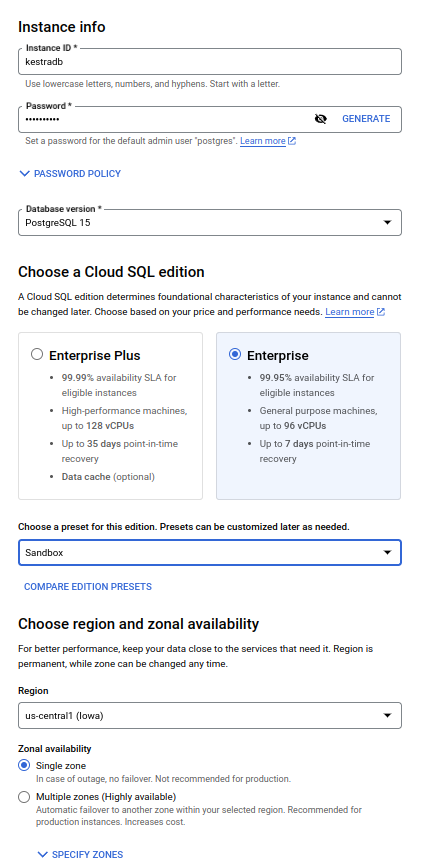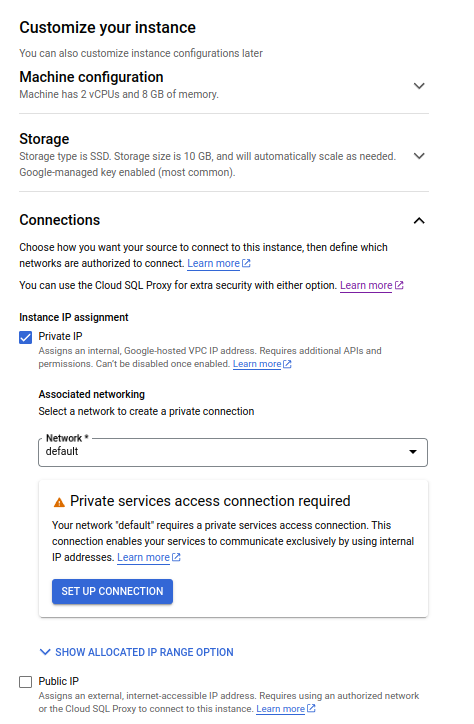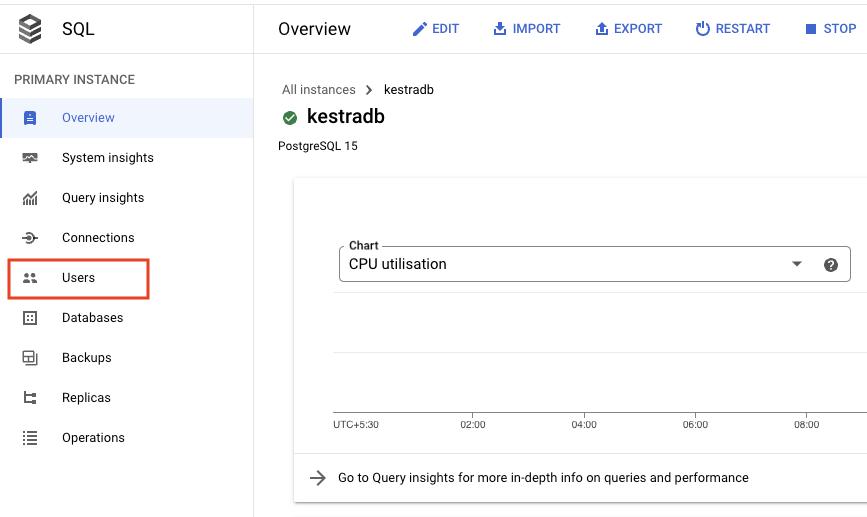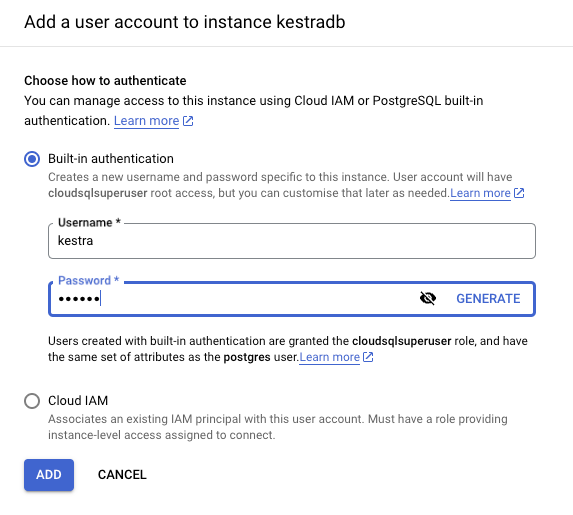 Kubernetes on GCP GKE with CloudSQL and Cloud Storage
Kubernetes on GCP GKE with CloudSQL and Cloud Storage
Deploy Kestra to GCP GKE with CloudSQL as a database backend and Google Cloud Storage as internal storage backend.
Overview
This guide provides detailed instructions for deploying Kestra to Google Kubernetes Engine (GKE) with CloudSQL as database backend, and Google Cloud Storage(GCS) for internal storage.
Prerequisites:
- Basic command line interface skills.
- Familiarity with GCP GKE, PostgreSQL, GCS, and Kubernetes.
Launch an GKE Cluster
First, login to GCP using gcloud init.
Run the following command to create an GKE cluster named my-kestra-cluster:
gcloud container clusters create my-kestra-cluster --region=europe-west3
Confirm using the GCP console that the cluster is up.
Before proceeding, check whether the gke-gcloud-auth-plugin plugin is already installed:
gke-gcloud-auth-plugin --version
If the output displays version information, skip this section.
You can install the authentication plugin using:
gcloud components install gke-gcloud-auth-plugin
Run the following command to have your kubecontext point to the newly created cluster:
gcloud container clusters get-credentials my-kestra-cluster --region=europe-west3
You can now confirm that your kubecontext points to the GKE cluster using:
kubectl get svc
Install Kestra on GCP GKE
Add the Kestra Helm chart repository and install Kestra:
helm repo add kestra https://helm.kestra.io/
helm install my-kestra kestra/kestra
Launch CloudSQL
- Go to the Cloud SQL console.
- Click on
Choose PostgreSQL(Kestra also supports MySQL, but PostgreSQL is recommended). - Put an appropriate Instance ID and password for the admin user
postgres. - Select the latest PostgreSQL version from the dropdown.
- Choose
Enterprise PlusorEnterpriseedition based on your requirements. - Choose an appropriate preset among
Production,DevelopmentorSandboxas per your requirement. - Choose the appropriate region and zonal availability.
- Hit create and wait for completion.


Enable VM connection to database
- Go to the database overview page and click on
Connectionsfrom the left-side navigation menu. - Go to the
Networkingtab, and click onAdd a Network. - In the New Network section, add an appropriate name like
Kestra VM, and put your GKE pods IP address range in the Network. - Click on
Donein the section. - Click on
Saveon the page.



Create database user
- Go to the database overview page and click on
Usersfrom the left-side navigation menu. - Click on
Add User Account. - Put an appropriate username and password, and click on
Add.


Create Kestra database
- Go to the database overview page, and click on
Databasesfrom the left side navigation menu. - Click on
Create Database. - Put an appropriate database name, and click on
Create.
Update Kestra configuration
Here is how you can configure CloudSQL Database in the Helm chart's values:
configuration:
kestra:
queue:
type: postgres
repository:
type: postgres
datasources:
postgres:
url: jdbc:postgresql://<your-db-external-endpoint>:5432/<db_name>
driverClassName: org.postgresql.Driver
username: <your-username>
password: <your-password>
Also, disable the postgres pod by changing enabled value in the postgres section from true to false in the same file.
postgres:
enabled: false
In order for the changes to take effect, run the helm upgrade command as:
helm upgrade my-kestra kestra/kestra -f values.yaml
Prepare a GCS bucket
By default, minio pod is being used as storage backend. This section will guide you on how to change the storage backend to Google Cloud Storage.
By default, internal storage is implemented using the local file system. This section will guide you on how to change the storage backend to Cloud Storage to ensure more reliable, durable, and scalable storage.
- Go to the Cloud Storage console and create a bucket.
- Go to IAM and select
Service Accountsfrom the left-side navigation menu. - On the Service Accounts page, click on
Create Service Accountat the top of the page. - Put the appropriate Service account name and Service account description, and grant the service account
Storage Adminaccess. Click Done. - On the Service Accounts page, click on the newly created service account.
- On the newly created service account page, go to the
Keystab at the top of the page and click onAdd Key.From the dropdown, selectCreate New Key. - Select the Key type as
JSONand click onCreate. The JSON key file for the service account will get downloaded. - We will be using the stringified JSON for our configuration. You can use the bash command
% cat <path_to_json_file> | jq '@json'to generate stringified JSON. - Edit Kestra storage configuration in the Helm chart's values.
Note: If you want to use a Kubernetes service account configured as a workload identify, you don't need to provide anything for serviceAccount as it will be autodetected for the pod configuration if it's well configured.
configuration:
kestra:
storage:
type: gcs
gcs:
bucket: "<your-cloud-storage-bucket-name>"
project: "<your-gcp-project-name>"
serviceAccount: "<stringified-json-file-contents>"
Also, disable the minio pod by changing enabled value in the minio section from true to false in the same file.
minio:
enabled: false
In order for the changes to take effect, run the helm upgrade command as:
helm upgrade my-kestra kestra/kestra -f values.yaml
You can validate the storage change from minio to Google Cloud Storage by executing the flow example below with a file and then checking it is uploaded to Google Cloud Storage.
id: inputs
namespace: company.team
inputs:
- id: file
type: FILE
tasks:
- id: validator
type: io.kestra.plugin.core.log.Log
message: User {{ inputs.file }}
Next steps
This guide walked you through installing Kestra to Google GKE with CloudSQL as database and Google Cloud Storage as storage backend.
Reach out via Slack if you encounter any issues or if you have any questions regarding deploying Kestra to production.
Was this page helpful?